
Poaceae or Gramineae is a large and nearly ubiquitous family of monocotyledonous flowering plants known as grasses. It includes the cereal grasses, bamboos and the grasses of natural grassland and species cultivated in lawns and pasture. The latter are commonly referred to collectively as grass.

In botany, an awn is either a hair- or bristle-like appendage on a larger structure, or in the case of the Asteraceae, a stiff needle-like element of the pappus.
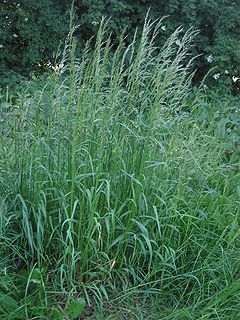
Arrhenatherum elatius, with the common names false oat-grass, tall oat-grass, tall meadow oat, onion couch and tuber oat-grass, is a perennial species of grass, native to Europe, western Asia, and northern Africa.

Eleocharis macrostachya is a species of spikesedge known by the common name pale spikerush.

Elymus elymoides is a species of wild rye known by the common name squirreltail. This grass is native to most of North America west of the Mississippi River and occurs in a number of ecosystems, from the alpine zone to desert sage scrub to valley grassland.

Elymus glaucus is a species of grass known as blue wild rye or blue wildrye This grass is native to North America from Alaska to New York to northern Mexico. It is a common and widespread species of wild rye.

Eragrostis cilianensis is a species of grass known by several common names, including stinkgrass, candy grass, and gray lovegrass.

Eragrostis hypnoides is a species of grass known by the common name teal lovegrass. It is native to the Americas from Canada to Argentina. It is found in moist areas near water in substrates of sand or mud.

Glyceria borealis is a species of Glyceria known by the common names northern mannagrass, boreal mannagrass, and small floating mannagrass. It is native to much of the northern half of North America, where it has a widespread distribution. This semiaquatic plant grows in wet areas in mountain forests, often in the water.
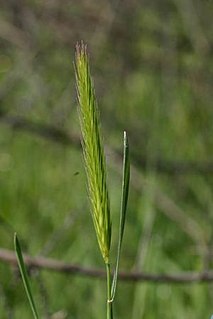
Hordeum brachyantherum, known by the common name meadow barley, is a species of barley. It is native to western North America from Alaska to northern Mexico, coastal areas of easternmost Russia (Kamchatka), and a small area of coastal Newfoundland.

Kyllinga brevifolia is a species of sedge known by several common names, including shortleaf spikesedge, green kyllinga, perennial greenhead sedge, and kyllinga weed. It is native to tropical areas in the Americas but it can be found in warm regions around the world where it is an introduced species. This is a rhizomatous perennial herb growing one to several erect stems to heights up to about half a meter, often much shorter. It produces tiny inflorescences of a few spikelets each which in total are less than a centimeter long. Pollens are tiny, approximately 20-30 microns in size. It is sometimes a weed in wet areas such as cultivated land and irrigation ditches.

Bothriochloa barbinodis is a species of grass known by the common name cane bluestem. It is native to the Americas, including most of South and Central America, Mexico, and the southernmost continental United States from California to Florida.
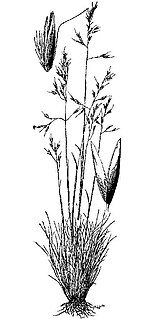
Calamagrostis breweri is a species of grass known by the common name shorthair reedgrass.
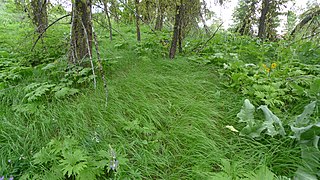
Calamagrostis rubescens is a species of grass known by the common name pinegrass.

Crypsis alopecuroides is a species of grass known by the common name foxtail pricklegrass. It is native to Europe, the Middle East, and North Africa. It is also known in the western United States as a common and widespread introduced species, especially in sandy areas around water, such as lakesides. It has also been collected at shipping points near Philadelphia but has not been seen there in about a century. This is an annual grass producing mostly upright and unbranching stems, often dark in color, up to about 75 centimeters in maximum height. The green leaves are up to 12 centimeters long, sometimes waxy in texture. The inflorescence is a dense cylindrical panicle of tiny green to purple spikelets.
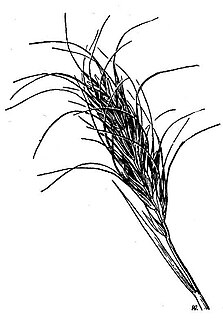
Elymus scribneri is a species of wild rye known by the common names spreading wheatgrass and Scribner's wheatgrass. It is native to much of the western United States and parts of central Canada where it grows in several types of habitat including alpine mountain peaks.
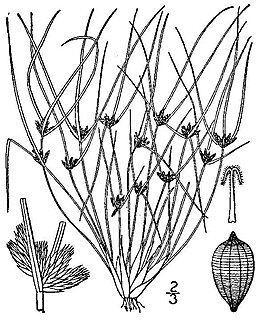
Fimbristylis vahlii is a species of sedge known by the common name Vahl's fimbry. It is native to much of Central America and the southern half of North America, where it grows in wet habitat. This is a small, clumping sedge producing rounded stems just a few centimeters high surrounded by curling, thready leaves. At the top of the stem is an inflorescence which is a cluster of several cylindrical, pointed spikelets surrounded by long, narrow, twisting bracts. The fruit is a tiny achene about half a millimeter wide.
Hordeum intercedens is an diploid, annual species of wild barley known by the common names bobtail barley and vernal barley. It is native to southern California and northern Baja California, where it is an increasingly rare member of the flora in saline and alkaline soils near seasonal waterflows and vernal pool habitats. Today most occurrences are located on the Channel Islands of California; many of the occurrences known from the mainland have been extirpated in the process of land development. This is an annual grass growing erect to bent in small tufts with stems up to 40 centimeters long. The inflorescence is a green spike up to 6.5 centimeters long made up of awned spikelets between 1 and 2 centimeters long.

Muhlenbergia richardsonis, known by the common name mat muhly, is a species of grass. It is native to North America, where it can be found throughout much of Canada, Alaska, the western half of the contiguous United States through California, and in Baja California, Mexico.

Cyperus trachysanthos is a rare species of sedge known by the common names pu`uka`a and sticky flatsedge. It is endemic to Hawaii, where it is known from Kauai and Oahu. It was known from Niihau, Molokai and Lanai, but it has been extirpated from these islands. It is a federally listed endangered species of the United States.



















